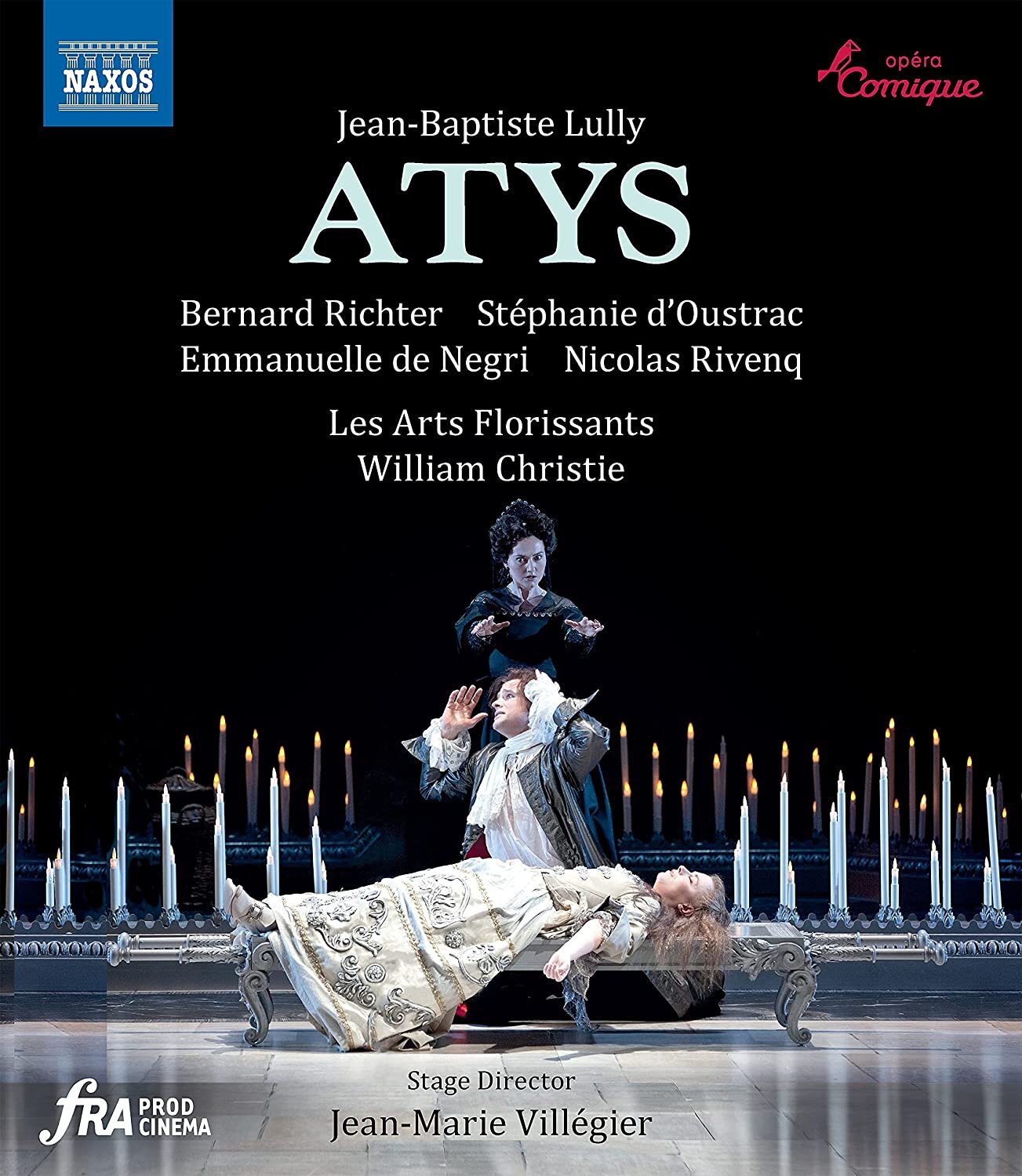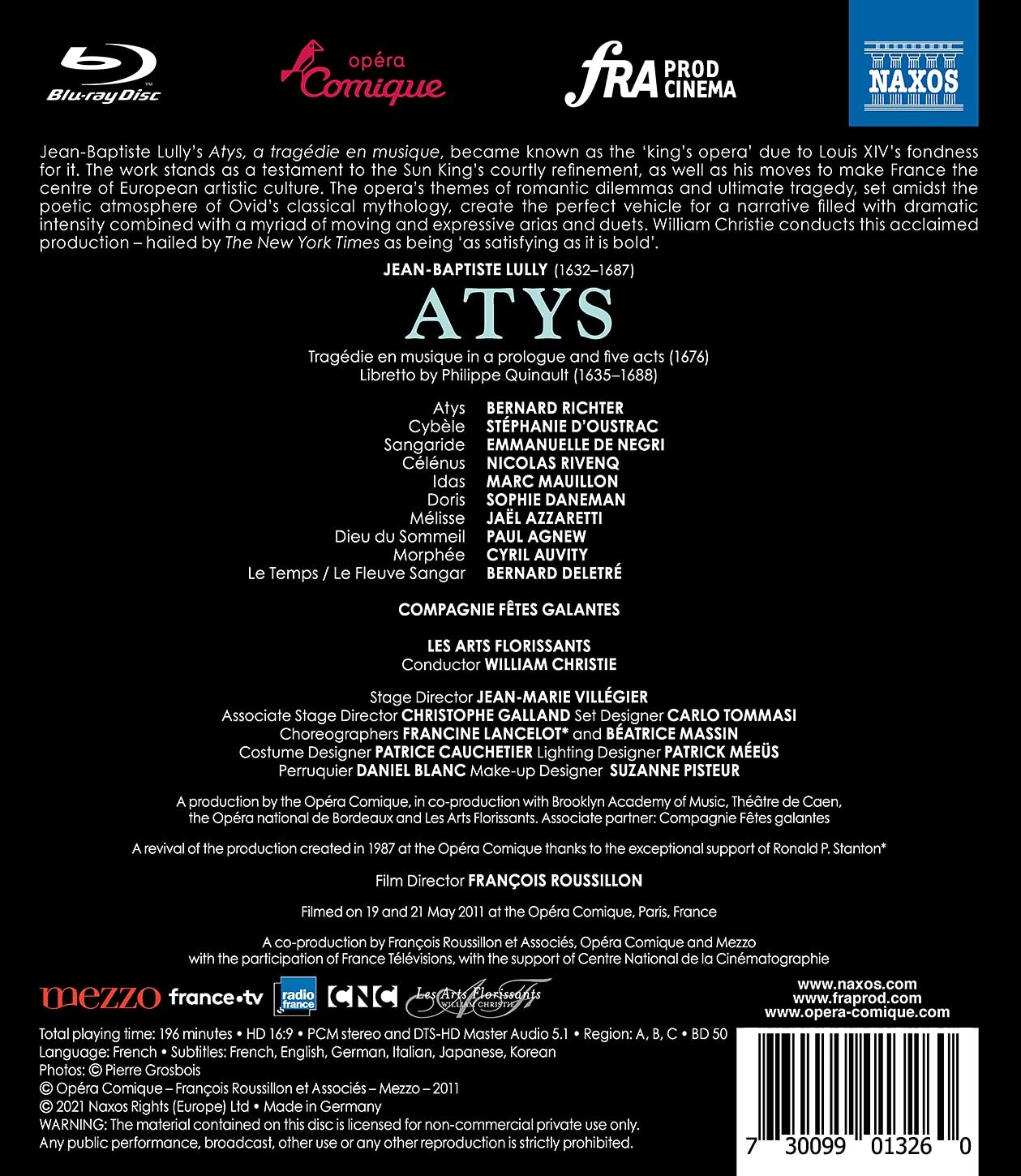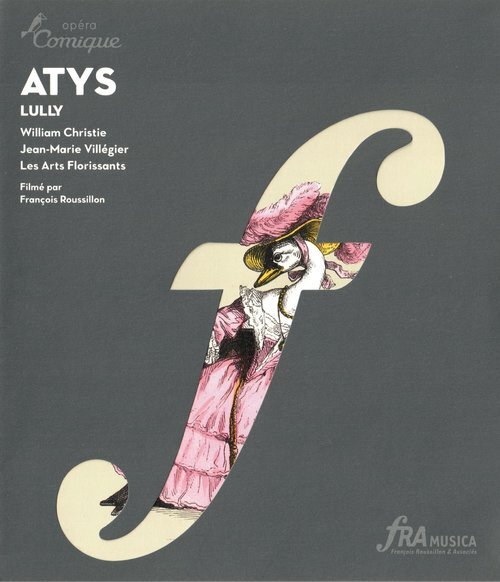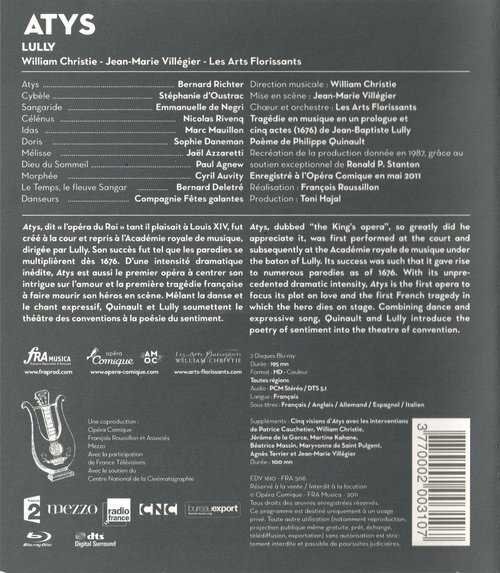



Jean-Baptiste Lully Atys opera to a libretto by Philippe Quinault. Directed 2011 at the Opéra Comique by Jean-Marie Villégier and associate stage director Christophe Galland. Stars Bernhard Richter (Atys), Stéphanie d'Oustrac (Cybèle), Emmanuelle de Negri (Sangaride), Nicolas Rivenq (Célénus), Marc Mauillon (Idas), Sophie Daneman (Doris), Jaël Azzaretti (Mélisse), Bernard Deletré (Le Temps/le fleuve [river] Sangar), Paul Agnew (Dieu du Sommeil), Cyril Auvity (Morphée), Callum Thorpe (Phobétor), Benjamin Alunni (Phantase), Arnaud Richard (Songe furneste), Jean-Charles di Zazzo (Maître des cérémonies/Alecton), Olivier Collin (L'impresario), Elodie Fonnard (Flore, suite de Sangar), Rachel Redmond (Iris), Anna Reinhold (Melpomène), Francisco Fernández-Rueda (Zéphir, suite de Sangar), and Reinoud Van Mechelen (Zéphir). Also stars the dancers of the Compagnie Fêtes galantes et Gil Isoart de l'Opéra national de Paris. William Christie conducts Les Arts Florissants. Choreography by the late Francine Lancelot and Béatrice Massin; set design by Carlo Tommasi; costumes by Patrice Cauchetier; lighting by Patrick Méeüs; wigs by Daniel Blanc; makeup by Suzanne Pisteur. Directed for TV by François Roussillon; produced by Toni Hajal. Sung in French. Released in 2021, disc has 5.1 dts-HD Master Audio sound. Grade: A+
This is a new version of a discontinued title previously released by FRA. (Above see the artwork for both versions.) The Naxos version is now the only Atys available new in Blu-ray. Atys is on some lists of best operas. But it began its life as No. 1 on the only list that mattered: it was the favorite opera of King Louis XIV of France. Remember L14? His reign of 72+ years was the longest in Western history. He built the Versailles near Paris. Times were good, and L14 is still called the “Sun King.” He remains the most famous example in Western history of the absolute monarch. (2 generations later L16 lost his head in the French Revolution.)
We start with some screenshots of the Prologue set in the palace of Father Time:
The hero Father Time lauds below is, of course, L14:
You probably didn’t notice in the 1st screenshot that the crown molding in the room is alive—it’s a splendid chorus representing the days and hours:
This opera has a huge cast. We can only identify some of the stars. Below left you see, Flore (Elodie Fonnard), the spirit of Spring. Below right she is joined by nymphs, peasants, and jesters. They want to enjoy the sunny weather:
But Melpomène, the Muse of tragedy, has loftier plans. She wants to tell the story of Atys. He was a hero who—though loved by men and gods—is totally destroyed for crossing his superiors. Left below is the our Melpomène (Anne Reinhold). This Muse is still hanging around. Below right you see her in the Library of Congress:
Next we meet Emmanuelle de Negri as Sangaride, a nymph and daughter of the Sangar River. She is soon to wed King Célénus. But she is in love with Atys, a human relative who happens to be a favorite of Célénus. This is going to cause problems:
Turns out Atys (Bernhard Richter) also secretly loves Sangaride. Now they both have problems with Célénus:
But there’s an even bigger problem! The local goddess, Cybèle, secretly loves Atys, and Cybèle is the most powerful protagonist of all. It’s time for Cybèle to appoint her High Priest. Below, all worship Cybèle and await her decision:
Behold below Stéphanie d'Oustrac as Cybèle. She carries a sprig from a pine tree. Both Atys and Sangaride are fated to disappoint both the King and the Goddess. Eventually, Atys will be ruined and become a pine tree in the forest. Nobody even cares what will happen to poor Sangaride:
As usual in Baroque opera, the plot sizzles with dizzying switchbacks and changes of fortune as the human and nymph try to elude the wrath of the powers that be. The Goddess, whose interest in Atys is pure lust, will get all the blame for the tragic end of the lovers. (A King can never be at fault for anything.)
D'Oustrac oozes vicious sexuality. She immobilizes Atys in a sleep scene:
There is a big orchestra in the pit, and the sleep scene gives opportunity for a stage band also! The band is joined by an incredible quartet of the Gods of Sleep (Sommeil), Dreams (Morphée), Nightmares (Phobétor), and Fantasy (Phantase):
There’s also dancing and a kind of jury pronouncing doom on Atys:
Cybèle suffers her own night of anguish knowing that Atys is in love with Sangaride:
Tears punctuate what may be the most impressive scene of soprano singing and acting ever recorded (Maria Callas is preserved in grainy black and white):
Yes, the hero and nymph are in serious trouble:
Even with these few screenshots you see the results of a huge investment in artists, sets, costumes, wigs, etc. making this one of the highest-quality productions ever of a baroque opera. This was thanks to a special gift from one Ronald P. Stanton. He arrived at age 9 in America one step ahead of the Nazis and went on to become a famous philanthropist and fan of baroque music.
Mixed in with the tragic situation is some comic relief skillfully directed by Jean-Marie Villégier. Witness below Francisco Fernández-Rueda portraying the River Sangar (Sangaride’s Daddy) as a lush completely smashed from drinking cognac straight out of his bottle. The man seated is Nicolas Rivenq as King Célénus:
But the end is harsh as can be. The rejected Goddess takes charge after consulting with Célénus:
She and her henchman Alecton (Jean-Charles di Zazzo) use magic to take control of the mind of Atys, who then slays Sangaride:
Atys commits suicide:
Now we come to the part that L14 really liked—no one should dare to cross the supreme power:
This is an exemplary title. The augmented orchestra and chorus of Les Arts Florissants conducted by Christie masterfully presents Lully’s hypnotic music—all vividly recorded with great SQ. The majestic music inspires impeccable singing and acting. Jean-Marie Villégier and associate stage director Christophe Galland beautifully direct the stars and a host of supporting extras and dancers. In these screenshots some of the images look dimly lit, but they glow the HT. It’s a hugely impressive example of an historically authentic show cloaked in a sparking clean style where everything appears to be new. You are convinced you that what you are seeing is better what L14 enjoyed. The audience thunders their appreciation with a huge ovation after Act 3 and during the elaborate curtain calls. François Roussillon provides state-of-the art video content with a satisfying mix of whole-stage, medium range, near, and close-up shots.
Because this is a reissue, most critics considered this old news. But Clive Paget gives this 5 stars in a review from January 2022 published in limelightmagazine.com.au. Judith Malafronte gives this her “Critic’s Choice” award in the February 2022 Opera News at pages 59-60. These comments from the press support my view that this is an important title. Still, this show may be too long and slow-moving for the casual opera fan. For years I was unable to get through the FRA version on my shelf. Only after I cut my teeth on a number of Handel operas was I ready to digest Lully’s gorgeous tribute to absolutism. A+.
PS: if you can get your hands on the old FRA edition, it has a lavish booklet and lots of extras on a second blu-ray disc. The Naxos version may not be so generous.
Here’s an official trailer for the Naxos Blu-ray:
OR



























